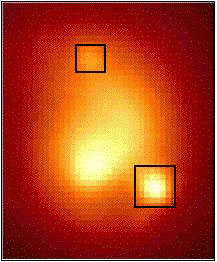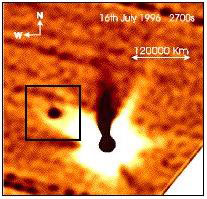|

by Robert
Roy Britt
Senior Science Writer
from
TheMilleniumGroup Website
courtesy
Space.com
 The
suggestion that comet Hale-Bopp might have a
satellite orbiting its nucleus, based on Hubble Space
Telescope images, has resurfaced amid doubts. The
suggestion that comet Hale-Bopp might have a
satellite orbiting its nucleus, based on Hubble Space
Telescope images, has resurfaced amid doubts.
Reporting in the current issue of Earth, Moon, and Planets,
an international journal,
Zdenek Sekanina of the Jet
Propulsion Laboratory writes about a Hale-Bopp satellite
detected by applying theoretical modeling to images taken with
Hubbleís Wide Field Planetary Camera 2 on five days during 1996.
If further research confirms the satellite, it would be the first
known cometary satellite discovered in a stable orbit,
Sekanina said in a telephone interview.(1)
While satellites have been spotted around other comets, in each case
they are drifting away from their host, destined to eventually break
free from the relatively minor gravitational tug. Hale-Bopp
-- which made its closest approach to the sun in 1997 -- is a huge
comet, and Sekanina said it is therefore a prime candidate
for being capable of binding a satellite into a stable orbit.
The satellite might have broken off the main nucleus during a
previous pass through the solar system, he said, possibly because of
the gravitational effects of Jupiter.(2)
Sekanina says the satellite is roughly 30 kilometers in
diameter (18 miles), compared with a main nucleus estimated to
be 70 kilometers across (43 miles). The two objects appear to
be separated by about 160 to 210 kilometers. The satellite appears
to take two or three days to complete an orbit, Sekanina
said.(3)
Skepticism
Harold Weaver, a research scientist in the Department of
Physics and Astronomy at the Johns Hopkins University,
has doubts about the report, which is based on Hubble Space
Telescope (HST) images Weaver has studied
(and actually provided to Sekanina). In a separate paper due
to appear in an upcoming issue of Earth, Moon, and Planets,
Weaver and a colleague, Philippe Lamy, make their case
against the possible satellite.
"We argue that
Sekaninaís conclusions about multiple nuclei cannot be
trusted because he is trying to extract more information from
the HST images than they contain," Weaver
told
space.com. "In particular, the
(detectors) on HST are not perfect devices, and
one has to be very careful about interpreting every íbump and
wiggleí in the data as evidence for companion nuclei. In other
words, we feel that Sekanina may be over interpreting the
data."(4)
Sekanina agrees
with Weaver that the satellite (or second nucleus)
does not appear on the Hubble image. "I donít see it
either," Sekanina said. But while Weaver is an
observer, Sekanina is a theorist. He starts with the
assumption that there is a satellite, then he tries to find it in
the data using a complicated modeling process that filters the light
reflected by dust surrounding the comet.
"The only way to
extract the nuclei (from the images) is to do a digital modeling
of the central cloud," Sekanina said. He applied two
different techniques to five separate images. "Iím reasonably
certain that something is there," Sekanina said, "because
I see it on each of the five images using two different models
of extraction of the dust cloud."
Weaver is
familiar with the modeling method, and respects Sekaninaís
work in general, but still he doubts that there is anything unusual
in the images. He noted the new paper is similar to previous papers
by Sekanina that used similar methods to reach a similar
conclusion.
(5)
"There are some
interesting new results in the (new) paper - but, in my opinion,
they do not strengthen the case for multiple nuclei," Weaver
said. "Of course, we could be wrong."
Another group of
researchers, writing in the September issue of Astronomy &
Astrophysics, claims evidence from ground-based observations
that indicates a second nucleus in Hale-Bopp.
This apparent second nucleus is a different one than that proposed
by Sekanina. It was derived by applying a technique called
adaptive optics, which attempts to filter effects of Earthís
atmosphere and resolve objects that otherwise are not apparent in an
image.
(6)
Weaver and Lamy also dispute this detection, based on
Hubble Telescope images taken at nearly the same time but
which do not show companions of the type claimed by the authors,
"even though they should have been easily detected in the Hubble
Space Telescope data."
Why does it matter?
Weaver said there are more than two dozen confirmed examples of
comets splitting into fragments, the most famous recent example
being
Comet Shoemaker-Levy 9,
which plowed into Jupiter in several stages. It is
therefore conceivable that relatively large fragments could have
broken away from Comet Hale-Bopp.(7)
"However, no one has
ever detected a bound companion to a cometary nucleus, as
Sekanina is claiming, so that would be very exciting,"
Weaver said. "There are now several known examples of binary
asteroids, and maybe comets sometimes also have stable
companions."(8)
If a comet had two
nuclei, Weaver said there is a chance the two could collide,
"which would temporarily produce a large outburst in activity by the
comet."(9)
Meanwhile,
Sekanina plans to get to work
figuring out the orbital details of his suspected satellite. One
result of that effort could be a better understanding of comets in
general.
"If we can calculate
the orbit, we could calculate the first mass of a comet ever,"
he said.(10)
COMMENTS:
by Gary D. Goodwin
(1) In
late 1995 it was reported on these pages that Hale Bopp
had numerous objects traveling with it. In fact we pointed out
that there were several of considerable size.
(2) Two
points here: First we stated repeatedly that this comet
was huge. However, secondly, it is still not understood,
or at least admitted by mainstream theorists that comets are
generally highly charged. Therefore, comets that are highly
charged have the ability, or rather display the behavior of
strong EMF. These sometimes very strong
electrical fields have the potential to maintain debris and
other bodies around them. This is not to say that these bodies
and/or debris can be torn from the primary body. There are other
important factors involved (such as centrifugal force), however
cometary bodies in general possess enormously powerful
electric fields.
(3) Itís
interesting to see the difference in size estimates. Dr.
Sekanina is one of the foremost cometary experts alive
today. However, we continue to believe that Hale Bopp
was and is incredibly large - on the order of thousands of
miles! Because the attachment is due to EMF,
we believe that there is not a regular orbit, or that it is
possible to hypothesize an orbit. The orbit has been very
irregular and not circular, at times bouncing at the end of the
EMF rope (so to speak) and then back - attempting
to circularize, but unable to due to the violent nature of the
cometary environment.
(4) Itís
very sad to see the critical and failing nature of science at
work here. Dr. Sekanina utilized strict scientific method
and critical observation to come to his conclusions. It appears
that Dr. Weaver has some apprehension that Sekanina
may be correct and jumped quickly to poopoo it. The fact is,
that there are numerous images, that we have posted, that
clearly show the presence of the satellite. You might ask
yourself what is so concerning about admitting the existence of
a Hale Bopp satellite? The simple fact is, that
the acceptance of such a theory opens the flood gate to the
theory of the Electric Universe and comets that are
highly charged, sucking up huge amounts of plasma as they
rip thru the inner, plasma rich, solar system. And if this is
true (which we strongly support), then the house of cards called
the Big Bang theory and its relatives - a
controlling society, fueled by a traditional scientific position
of proof at all costs - will simply blow away in the face of
this new reality.
(5) Once
again we are witnesses to this attitude of pride and competition
in the scientific community. Unfortunately this has kept the tax
paying community from receiving the greater benefits that
science has to offer. Critical review is a necessary and
important concept, however rigid unacceptance due to a need to
control is not helpful. Remember... the Hubble Space
Telescope is owned by the tax paying public. I will not be
surprised if we are asked to remove this article from these
pages due to these comments.
(6)
Adaptive optics have been used on the telescopes at the Air
Force station called AMOS. This is a very
controversial approach and has been widely withheld from the
public. However there are many different approaches that may
fall in to the category of "Adaptive Optics".
(7) WRONG!
The last comet to be shown to fragment was Comet Lee.
Fragmenting is not at all an uncommon thing to occur with
comets. SL9 has been referred to as a comet, but
it should be noted that SL9 was not observed to
have any hydrogen in it, thus defeating the traditionally
accepted theory of the dirty snowball comet. This lack of
definable hydrogen (water), could be explained in that it had
not reached the plasma rich inner solar system.
There is however a limited amount of hydrogen (plasma)
around Jupiter. Thus there was a limited tail seen
with this group of objects. And further there appears to have
been recently a great increase in EMF activity
surrounding Jupiter and its moons.
 (8)
Well unfortunately, we are not accepted by the status quo as
acceptable sources of information. Even though we have
documented on several occasions the electromagnetic disposition
of cometary and other solar system objects. But it does a heart
good to see a well known and accepted scientist, such as Dr.
Sekanina to lean toward our findings! (8)
Well unfortunately, we are not accepted by the status quo as
acceptable sources of information. Even though we have
documented on several occasions the electromagnetic disposition
of cometary and other solar system objects. But it does a heart
good to see a well known and accepted scientist, such as Dr.
Sekanina to lean toward our findings!
(9)
Actually with a dielectric field, it is to a degree, unlikely
that the tag-alongs could collide with the primary. But due to
the violent nature of the cometary environment common
reorganization of the core materials is possible if not likely,
depending upon the core minerals involved. The fact of the
matter is, that these things are not yet fully tested out.
(10) I can
only hope that Dr. Sekanina, like Dr. Charles Morris,
is reading our pages often.
|

 The
suggestion that comet Hale-Bopp might have a
satellite orbiting its nucleus, based on Hubble Space
Telescope images, has resurfaced amid doubts.
The
suggestion that comet Hale-Bopp might have a
satellite orbiting its nucleus, based on Hubble Space
Telescope images, has resurfaced amid doubts. 